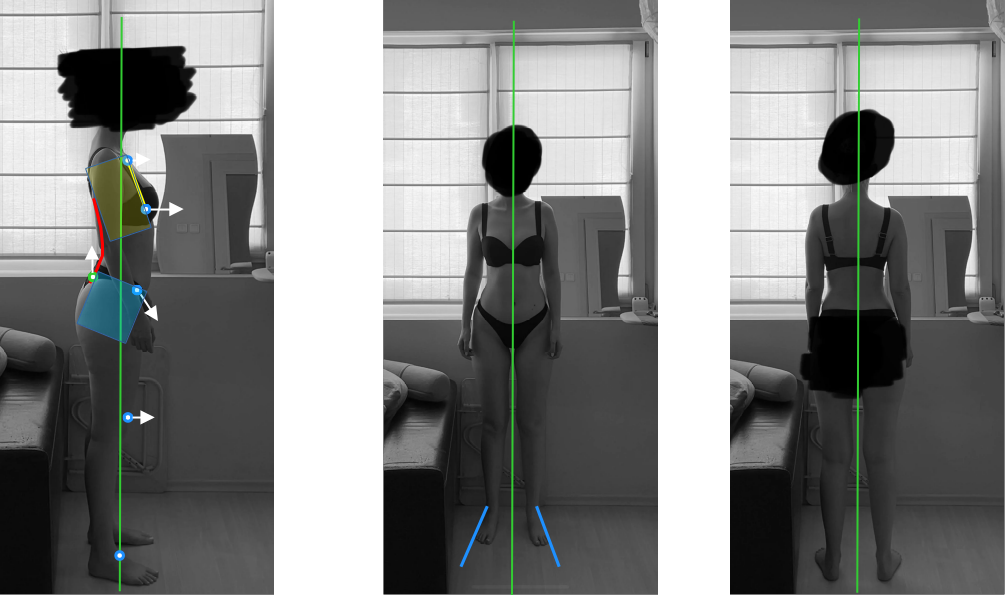Assessment context and image originals from this thread: https://www.reddit.com/r/PostureTipsGuide/comments/15kix5s/neck_hump_and_left_shoulder_higher_than_the_right/

What we see is a very common mal-coordination of human mechanism.
Feet are placed in a wrong position for standing. The toes are apart, heels together. On the frontal view, I outlined 2 blue lines - your "outsteps". these two lines should be parallel when standing, at the moment, they are converging at the back.
The green plumb line always gets set to the "ankle point", which is the front of your talus bone and that where the entire mechanism pivots above the foot. This point will always be on the green line.
Going up, you see your knees slightly forward, that is your knees are released (not in full extension).
Your pelvis (the blue square) is tilted (APT). That is, your iliacs (the blue marker at your waist height - [anterior suprerior iliac spine] is considerably shifted forward from the green line, as well as down. Together with that, your sacrum (green marker) is being lifted too high. The sacrum and the iliacs are two points of the same object (pelvis) and will always move together (when the pelvis moves).
The arrows suggest that if you move the iliacs forward and down (and sacrum up), it will start creating a rotation of your pelvis. You can also often use the "belt line" - that is the top of your underwear (where belt would normally be situated) - your beltline is sloping down at the front. We would like the belt line to be horzinotal. When seen on this image, we could say that the pelvis has rotated "clockwise" from where we would normally like to have it. Remember this for later.
Your ribcage (yellow rectangle) is also rotating, however in this case it would be the opposite - that is "counter clockwise". It can be easily measured by the backwards slant of the yellow line at front (which is your sternum and the actual front of your ribcage. The two blue markers at the top are your bottom and top sternum respectively.
The red curve in then back is your spine that joins your pelvis object and your ribcage object. When the two objects rotate in opposing dirrections, the highly articulated spine between gets "bent" as you can see on image.
If you would imagine that you would reverse the direction of the rotations for both - the ribcage and the pelvis, it would create forces that would straighten the red curve (and that's what we want).
For reference, all the blue markers should be placed on the blue line and the red curve should be totally flat. If you would be able to do that, you would ensure that your mechanism works correctly. (totally possible to do). At the moment, the red curve means you are shortening your torso (torso = pelvis + spine + ribcage, no arms, no legs,n no head / neck). This shortening comes at a cost : you are restricitng your breathing, circulation and digestion, not mentioning the fact that you are loading your joints in a way they haven't been designed to handle.
You also have slight left / right imbalances (twists). Not too bad, but present. The fact that your left shoulder is higher is due to you retracting the left arm further back than the right. You can also see asymmetries @ your waist (visible) and there will be differences in the position of your feet (one will be further forward to the other) and knees.
All of these twists are there to satisfy your equilibrium. When one part of the mechanism gets "out of whack" the rest of the mechanism also has to react in order to compensate for the shift of the mass.
Oh, and I forgot to mention that your arms are shifted too much back (and so will be your head).
All this is happening because of how you move. The relative movements of each part in relation to the other parts (mainly in your torso) are currently habitual, subconscious. As in you never deliberately asked to be like this, it just happens.
To get out of this, you could learn to move the parts to each other differently and start obtaining "shape" of your posture that is mechanically more advantageous.
All we see above is perfectly fixable with education. You first learn how the mechanism is designed, how it should be operating and then you would deliberately learn to move the parts differently. However, it won't fix itself. You woudl have to put effort into it.
If there is more questions, please ask.